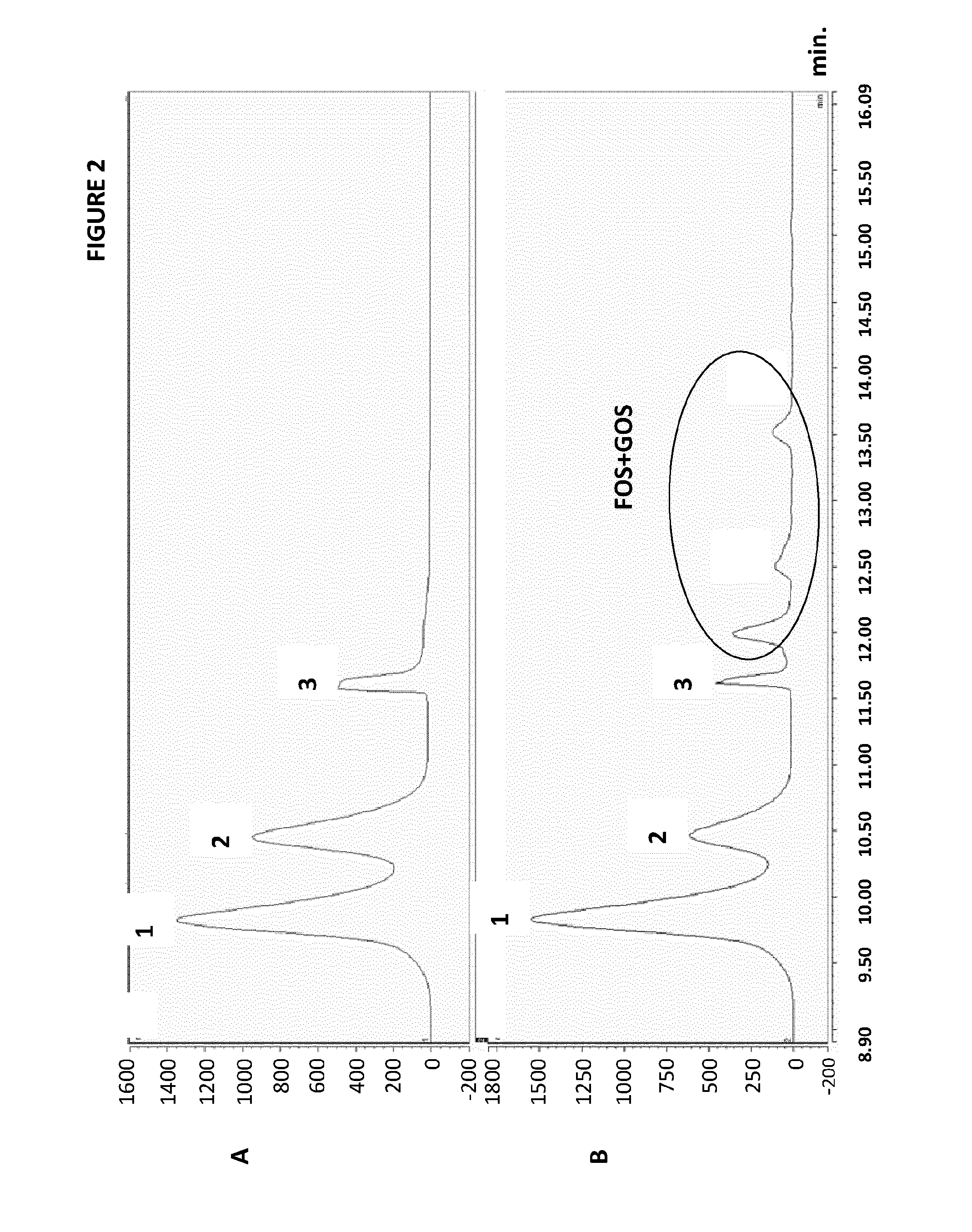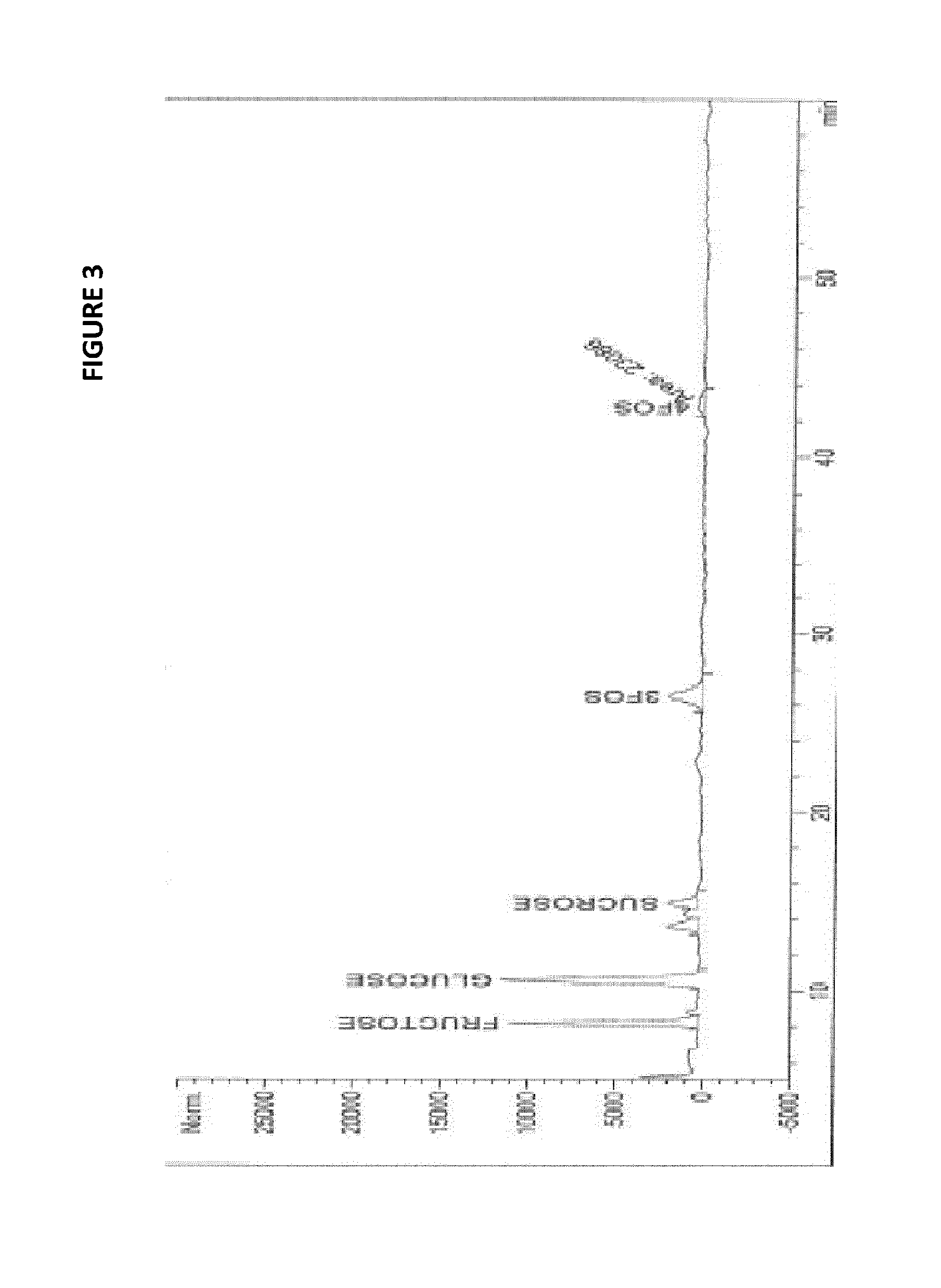Intrinsic sugar reduction of juices and ready to drink products
a technology of raw materials and sugar, applied in the field of raw materials and ready to drink products, can solve the problems of negative health effects of high consumption of simple sugars, and achieve the effects of nutritional food products, and reducing the intrinsic sugar content of food products
- Summary
- Abstract
- Description
- Claims
- Application Information
AI Technical Summary
Benefits of technology
Problems solved by technology
Method used
Image
Examples
example 1
Sucrose Reduction in Model Solution by Using Dextransucrase
[0097]The sucrose reduction was studied in model solution with the same sugar ratio and concentration of sugars present in orange juice concentrate. The sugar solution was treated with 0.014% (w / w) dextransucrase from Leuconostoc mesenteroides B-512F (Sigma, Franklinton NC) for 28 h. The reaction was carried out at 30° C. and the pH was adjusted to 5.2. Samples were drawn at appropriate time intervals and heated at 90° C. during 5-10 min to stop the enzyme activity. The residual sucrose content was analyzed by HPLC with a pump (Agilent 1100 Series) coupled to a carbohydrate column (Shodex amino column Ashipak NH2P-50 4E). A refractive index detector was used. The mobile phase was 75% (v / v) acetonitrile. The concentration of sucrose was determined from peak areas by using standards of this sugar. Table 1 shows the reduction of sucrose in the model solution for the action of dextransucrase. The amount of sucrose reduced was co...
example 2
Sugar Reduction in Orange Juice Concentrate by Using Dextransucrase
[0098]The in situ sugar reduction was studied in orange juice concentrate (OJC). The sugars present initially in OJC were sucrose, glucose and fructose. The OJC was treated with 0.036% (w / w) dextransucrase from Leuconostoc mesenteroides B-512F for 4 h. The reaction was carried out at 30° C. and the pH was adjusted to 5.2. Samples were drawn at appropriate time intervals and heated at 90° C. during 5-10 min to stop the enzyme activity. The sugar content of the samples was analyzed by a HPAEC Dionex system. This high performance anion exchange chromatography method used a cartridge column C18 coupled with pulse amperometric detector. The eluent was a gradient solution of NaOH. The chromatograms obtained show the formation of different types of oligosaccharides after treatment (FIG. 1B) when compared with the chromatograms obtained before treatment (FIG. 1A). The total sugar reduction was assessed by calculating the dif...
example 3
Gluco-Oligosaccharides (GOS) Formation in Model Solution by Using Dextransucrase
[0099]The GOS formation was studied in model solution with similar sugar ratio and concentration of sugars present in orange juice concentrate. The reaction conditions were similar as the conditions in example 1. The sugar solution was treated with 0.014% (w / w) dextransucrase from Leuconostoc mesenteroides for 20 h. The reaction was carried out at 30° C. and the pH was adjusted to 5.2. Samples were drawn at appropriate time intervals and heated at 90° C. during 5-10 min to stop the enzyme activity. The sugar content of the samples was analyzed by HPLC. Table 3 shows the reduction of sucrose in the model solution for the action of dextransucrase. The amount of sucrose reduced was converted to gluco-oligosaccharides and monosaccharides. Even though different oligosaccharides peaks were observed in the chromatograms after the enzymatic reaction, due to the lack of GOS standards, the GOS content was calculat...
PUM
 Login to View More
Login to View More Abstract
Description
Claims
Application Information
 Login to View More
Login to View More - R&D
- Intellectual Property
- Life Sciences
- Materials
- Tech Scout
- Unparalleled Data Quality
- Higher Quality Content
- 60% Fewer Hallucinations
Browse by: Latest US Patents, China's latest patents, Technical Efficacy Thesaurus, Application Domain, Technology Topic, Popular Technical Reports.
© 2025 PatSnap. All rights reserved.Legal|Privacy policy|Modern Slavery Act Transparency Statement|Sitemap|About US| Contact US: help@patsnap.com



